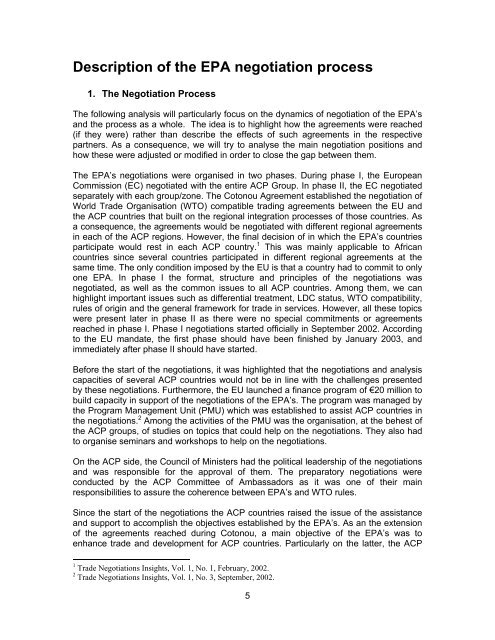EPA Review Annex Documents - DFID
EPA Review Annex Documents - DFID
EPA Review Annex Documents - DFID
You also want an ePaper? Increase the reach of your titles
YUMPU automatically turns print PDFs into web optimized ePapers that Google loves.
Description of the <strong>EPA</strong> negotiation process<br />
1. The Negotiation Process<br />
The following analysis will particularly focus on the dynamics of negotiation of the <strong>EPA</strong>’s<br />
and the process as a whole. The idea is to highlight how the agreements were reached<br />
(if they were) rather than describe the effects of such agreements in the respective<br />
partners. As a consequence, we will try to analyse the main negotiation positions and<br />
how these were adjusted or modified in order to close the gap between them.<br />
The <strong>EPA</strong>’s negotiations were organised in two phases. During phase I, the European<br />
Commission (EC) negotiated with the entire ACP Group. In phase II, the EC negotiated<br />
separately with each group/zone. The Cotonou Agreement established the negotiation of<br />
World Trade Organisation (WTO) compatible trading agreements between the EU and<br />
the ACP countries that built on the regional integration processes of those countries. As<br />
a consequence, the agreements would be negotiated with different regional agreements<br />
in each of the ACP regions. However, the final decision of in which the <strong>EPA</strong>’s countries<br />
participate would rest in each ACP country. 1 This was mainly applicable to African<br />
countries since several countries participated in different regional agreements at the<br />
same time. The only condition imposed by the EU is that a country had to commit to only<br />
one <strong>EPA</strong>. In phase I the format, structure and principles of the negotiations was<br />
negotiated, as well as the common issues to all ACP countries. Among them, we can<br />
highlight important issues such as differential treatment, LDC status, WTO compatibility,<br />
rules of origin and the general framework for trade in services. However, all these topics<br />
were present later in phase II as there were no special commitments or agreements<br />
reached in phase I. Phase I negotiations started officially in September 2002. According<br />
to the EU mandate, the first phase should have been finished by January 2003, and<br />
immediately after phase II should have started.<br />
Before the start of the negotiations, it was highlighted that the negotiations and analysis<br />
capacities of several ACP countries would not be in line with the challenges presented<br />
by these negotiations. Furthermore, the EU launched a finance program of €20 million to<br />
build capacity in support of the negotiations of the <strong>EPA</strong>’s. The program was managed by<br />
the Program Management Unit (PMU) which was established to assist ACP countries in<br />
the negotiations. 2 Among the activities of the PMU was the organisation, at the behest of<br />
the ACP groups, of studies on topics that could help on the negotiations. They also had<br />
to organise seminars and workshops to help on the negotiations.<br />
On the ACP side, the Council of Ministers had the political leadership of the negotiations<br />
and was responsible for the approval of them. The preparatory negotiations were<br />
conducted by the ACP Committee of Ambassadors as it was one of their main<br />
responsibilities to assure the coherence between <strong>EPA</strong>’s and WTO rules.<br />
Since the start of the negotiations the ACP countries raised the issue of the assistance<br />
and support to accomplish the objectives established by the <strong>EPA</strong>’s. As an the extension<br />
of the agreements reached during Cotonou, a main objective of the <strong>EPA</strong>’s was to<br />
enhance trade and development for ACP countries. Particularly on the latter, the ACP<br />
1 Trade Negotiations Insights, Vol. 1, No. 1, February, 2002.<br />
2 Trade Negotiations Insights, Vol. 1, No. 3, September, 2002.<br />
5
















